Even when times are good, foraging can save you a good bit on your grocery bills. In a crisis it can make the difference between life and death.
When society is falling apart, stores are empty or looted and you’re trying to make your food stores last as long as possible, foraging is a resource you can turn to right away.
Growing your own crops is a great way to ensure your food supply, but if you don’t already have them in the ground when disaster strikes you’ll probably be waiting months before you get your first crop in.
⇒ How To Build A Hidden Food Growing Fence In Your Backyard
Foraging will help get you through until your garden starts producing.
If you need to move to a new location foraging, along with hunting, is one of the food sources you can start to exploit right away.
Foraging should have a role to play in any prepper’s plans. Of course, how much food foraging can provide depends on where you are.
Some environments will produce food quite easily, while others are more challenging – and in some, most people will struggle to find any food at all.
So, if you want to be able to forage productively, what are the best states to do it in?
Washington
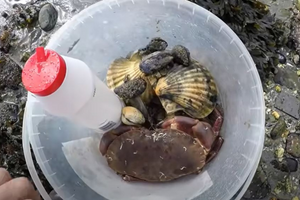 All the West Coast states are good for foragers, but Washington is probably the winner.
All the West Coast states are good for foragers, but Washington is probably the winner.
Rocky areas of the coast have plenty of shellfish, including clams, mussels and oysters. Collect healthy-looking ones, which have closed shells and are firmly attached to the rocks.
It’s also worth checking rock pools for crabs and trapped fish. Meanwhile you can also collect edible seaweed.
Further inland, around half of Washington is covered in forest. Some of these trees are a good source of food.
For example Douglas firs are very common, and in spring the soft tips of the branches can be collected and eaten.
⇒ How To Make Bark Bread From A Tree That Grows On Almost Every Street In America
Camassia plants are common in the forests, and their bulbs are nutritious; they can be roasted or boiled. There are also plenty of wild berries in and around the forests.
Eastern Washington has few forests and foraging there is more difficult, but look for wild asparagus along roadsides and on the banks of ditches.
Maine
On the other side of the country, Maine has many of the same foraging advantages as Washington. On the coast you can find edible kelp, Irish moss and other seaweeds.
Sheltering under the seaweed are green crabs, and on the rocks look for mussels and periwinkles. Muddy banks are a good place to find quahog clams, the basis of the classic New England clam chowder.
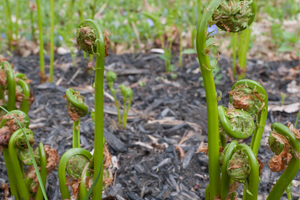 Inland there’s still plenty food to collect. In spring fiddlehead ferns are common; collect the young, curled tips and boil them.
Inland there’s still plenty food to collect. In spring fiddlehead ferns are common; collect the young, curled tips and boil them.
If you have the skills to identify edible mushrooms you’ll find plenty of them in Maine, including morels and chicken of the woods.
The state’s ponds and marshes have endless supplies of cattails, one of the most versatile plants you can forage. Then, of course, there are huge expanses of wild blueberries.
In fall there are wild apples to collect. Pine nuts take some work to collect, but there’s no shortage of pine trees. In winter you can collect reindeer moss, which is edible; just boil it for a couple of minutes.
Maine is a great place to forage even when there isn’t a crisis. The state has permissive land laws that allow foraging on any land unless there are posted signs forbidding it.
Iowa
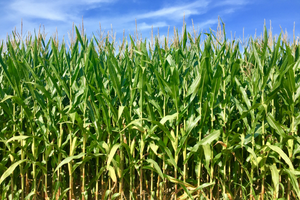 Iowa is a major agricultural state – 60% of it is farmland.
Iowa is a major agricultural state – 60% of it is farmland.
While farmers don’t like foragers helping themselves to their produce there’s plenty food around if the SHTF.
Major crops that can turn into forage in a crisis include corn, soybeans and oats.
Because these are cultivated species they’re highly nutritious; all of them are energy-dense, and soy has a lot of protein too.
If you don’t want to forage in the fields there are non-crop foods to be foraged in Iowa. Look in hedges and along roadsides for berries and wild asparagus. There are also patches of woodland between farms where you can find more berries and mushrooms.
Related: If You See This Berry, You May Want To Harvest It
In a crisis, your best bet is to forage around farms. As well as large-scale agriculture there are a lot of smaller organic farms in Iowa – around 800, and the number is growing – and seeds from their crops often escape over the boundaries.
Whatever the farm is growing you have a good chance of finding some that’s taken root outside the fence.
Texas
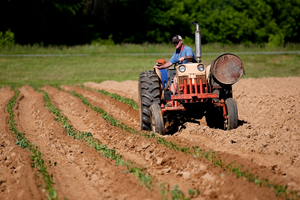 With the nation’s biggest agricultural industry, including large farms producing cereals, fruit and onions, Texas has all the same post-apocalypse possibilities as Iowa.
With the nation’s biggest agricultural industry, including large farms producing cereals, fruit and onions, Texas has all the same post-apocalypse possibilities as Iowa.
If farms haven’t been abandoned there are plenty of wilder areas where food can be found.
Sorrel is common in grasslands and forests, and can be used as a green vegetable. Wild carrots are also abundant, especially along roadsides; just make sure you know the difference between them and hemlock, which is poisonous. Wild carrot leaves are the ones with hair.
Texas also has a good range of wild nuts, including black walnuts and pecans, which can be harvested in fall. Look out for loquats, a yellow fruit that originally comes from China but now grows in many parts of the South.
Many species of grass in Texas and other Southern states are edible. The seeds can be collected and either boiled or dried and ground into flour.
If you can identify an edible species you should be able to harvest large quantities of carbohydrates and fiber. Other edible plants that grow widely in Texas include smilax, wild grape and purslane.
California
The California coastline, like Washington’s or Maine’s, is a great place to forage for shellfish and seaweed. Search rocks for barnacles, clams and mussels – but be careful. If there’s a “red tide” of algae, shellfish can collect lethal doses of toxins, so only collect shellfish when the sea is clear. Edible seaweeds including sea lettuce and nori are common in California.
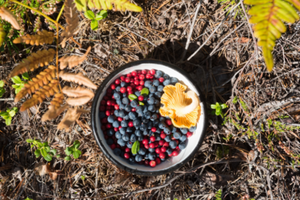 Inland, Northern California has a variety of berries and other edible plants.
Inland, Northern California has a variety of berries and other edible plants.
Wild radish has edible seed pods and stems can be shaved to reveal the crispy edible center. Further south you can find amaranth, wild asparagus, chickweed, pennycress and even prickly pear cactus.
Related: 10+ Wild Foods You Should Forage For This Summer
Although I’ve rated these five states as the best for foraging, you can do very well in most other states too. There are edible plants everywhere; you just need to learn to recognize the ones that grow in your state, and where to find them.
You should also know how to do the taste test to check plants for edibility:
- Only test one plant at a time.
- Rub a small piece of the plant on your forearm and wait 15 minutes to check for a reaction.
- Touch a piece to your lip to check for a burning or itching feeling.
- Put a small piece in your mouth then spit it out again. A burning or prickling sensation, or a taste of almonds, means it’s toxic and should be avoided.
- If there’s no reaction or almond taste, swallow a small piece of the plant and wait an hour for any reaction. If there isn’t any reaction the plant should be safe to eat.
- Remember this test only works on plants. IT DOES NOT WORK ON MUSHROOMS.

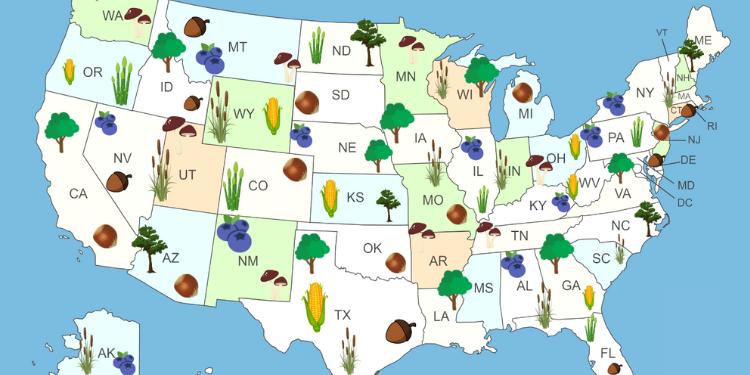













Well good try
Cat Tails, lobsta, weirs for tuna used to be big in Maine.
Liquor stores for hooch, abandoned farms for hooch ingredients.
I would like an article concerning hops and mash in general.
A good article to further spur interest in foraging. On just our nine acres we have elderberry, lemon balm, Himalayan black berry, filbert, black walnut, and a few others like Oregon grape and puff ball mushroom. The goats keep the black berry in check and eliminate some other things like filbert when the can reach them. Steller’s Jays get the filberts as well, so when we see them with nuts, it’s time to get them picked. We hang the nuts in mesh bags to finish curing. A good resource to find foraging locations is to study the areas Native Americans lived in. In Washington State Many peoples lived along the coast and rivers Like the Makah, and Yakama, along with many others. Camas, Washington is named after the Camas fields that used to grow in abundance. Every year indigenous peoples like the Yakama, Nez Perce and others would travel there to harvest, cook (with long fires) , and process Camas Root.
And they are comming for you!
Good luck foraging in the places you name in January.
The north marine Pacific coast of Washington State will yield food year around in fish, mollusks, and kelp as well as rose hips, dandelion root, and cat tail. The Makah thrived in this region.
Old Para,
I once picked a bowl full of big red rose hips that were growing wild by a river. When I cut into them, each one was filled with worms. It might be a good idea to be ready to live with extra protein in some wild crafted foods.
Another factor I discovered in that area by the river was a bear or two. I was aiming for a specific type of wild blackberry and I discovered that the bear also preferred that type of blackberry. In that same area, the coyotes were afraid of me but not a little 8 year old child. They started started going after him.
There might not be fun and enjoyable food but there is food, even in the dead of winter. The inner bark of evergreens is good for food. The pine needles are great for tea. Both have shikimic acid which will help with prevention and recovery from illnesses. If you’re really hungry, there are grubs. From what I have heard, is that you hold the head and bite off the body to eat. Some have even said that the grubs have a sweetish flavor. Yum, yum.
The states mentioned have LOUSY gun laws and their idea of the US Constitution sucks lemons!!! The author isn’t the sharpest knife in the drawer!!!!!!
Thomas Spencer,
Yes, not all of the states mentioned adhere to The Constitution. And, any state you can name has pockets of conservatives and liberals, good people and bad people, smart people and not so smart people, but that does not mean it’s a bad state, it just means that you may not be a good fit as a citizen. I don’t care whether you like chocolate ice cream or vanilla, but to condemn all based on your dislikes is not becoming to a prepper.
Can you forage for food 365 days per year in all states? I won’t say no because I am not positive, but I will agree that certain times of the year are better than others. And because we are preppers, we should be foraging enough for our immediate needs, and also extra for longer term.
As far as gun laws, I don’t agree with any infringement, but some people are happy to sacrifice their freedom for some short lived security. When SHTF happens, those gun laws will not be enforceable, nor should they be enforced, but before anyone picks up a gun, they need to have respect for and knowledge of said gun.
I do not agree that the author has included farms, even abandoned farms, as a potential foraging location. I believe large groups/gangs or the government will lay claim to those farms first. Even if it is abandoned, you may be harmed in your attempt at foraging for survival.
I come to this site for both education and a good laugh. Some articles have been very informative, while other articles lack some of the depth hoped for. Some include links to other information that will allow you to dig deeper into what the author is attempting to convey. Do I care about learning how to forage in Washington or Maine? Not in the least, but do I want to know about some of the plants that people find in abundance there. The plant may not grow in my area, but knowing about the plant may lead me to learn about others that do grow in this drought ridden hell hole.
BTW, I look forward to the next article that you have published on this site. I am sure it will be most fascinating since you will have researched all possible scenarios, laws, and locations that will educate and appeal to everyone.
“When SHTF happens, those gun laws will not be enforceable, nor should they be enforced, but before anyone picks up a gun, they need to have respect for and knowledge of said gun.”
You’re either out of your brainwashed mind or you’re just a silly bootlicker. Remember Katrina??? Not only did they enforce gun laws, they invented new ones to justify TOTAL CONFISCATION. Meaning, they took guns from ALL law abiding citizens, taking away their means of self defense when everything and everyone was in crisis. You’re a fool if you think they won’t take all they can get away with.
The article’s about foraging. What do gun laws have to do with it?
Texas has lots of wild lettuce now. It has not always been this way. I’m 63 and have spent lots of time outdoors and have not seen wild lettuce until about 4 years ago. Try to stick to the virosa strain. It’s not as bitter and more tender than the serriola strain.
Foraging a farmer’s crop will probably get you a load of buckshot. Years ago it was customary in the Rio Grande Valley of Texas to allow the poor into the fields after harvest to glean the corn and beans left behind. This in accordance with Deuteronomy 23:25, When you enter your neighbor’s grainfield, you may pluck the heads of grain with your hand, but you must not put a sickle to your neighbor’s grain. Sadly, back in the 1970s, Texas made gleaning illegal. Truth be told, if you are in the Mid-West the best use for a grain field is to go there and shoot the Canada Geese that are gleaning the fields, killing the animal that forages is the only way to live off the land, truth be told.
Trumpeter and Tundra Swans do immense damage to the farmer’s fields in Washington state. They used to migrate but have found stripping the fields easier. It is illegal to shoot them even though there are so many of them. I do know at least one farmer in that state that allowed generous gleaning rights to specific people.
Florida is an outdoor supermarket year round. You can grow crops and with fish nets can feed a village all year. If the Great Reset happens and SHTF, life will get better, imo. Supply chains will be local, small markets will thrive, family and friends will become more relevant in daily life.
Hurricanes are no big deal if you build for them. We have never evacuated and live on the coast.
Chuck needs it
Aren’t those like all blue demonkrap states?
Hey Raven,
Come on man! Your demented brain can do better than that!
Obama’s National Police
& security Force Plan
July 2, 2008,
Colorado Springs, CO
“We cannot continue to rely on our military
in order to achieve the national security
objectives we’ve set.
We’ve got to have a civilian
national security force that’s just as
powerful, just as strong, just as well-funded”
The DemoCommunist party has added 86,852 agents to the existing 78,661 agents for a new total of 165,513 IRS Agents.
Why did the IRS buy 5,000,000 rounds of ammo?
3,151,500 rounds of pistol ammo.
Over 350,000 rounds of shotgun ammo.
Almost 1.5 million rounds of rifle ammo.
The obvious question is why would a bunch of bean counters who spend their days staring at computer screens need to stock up on millions of rounds of ammo?
To shoot the people
At this moment, there is a new transplant to Tennessee covered in a painful itchy skin condition. She forgot about looking out for poison oak when cleaning up the edges of the property. It has gone from being a surface skin issue to being systemic. Her place has a couple of ponds that have snapping turtles, which are said to be edible. The prepared meat is really expensive so it must taste okay. I just don’t know if I could handle processing the meat because turtles continue to move around long after their heads are cut off.
I’ve lived many years on the west coast and now live in the Southeast. I can tell you that foraging here is at a completely different level and 1000X better.
Does anybody have any feedback on Verginia? my wife and I wish to Relocate there and although I have served in the Army for many years, I’m a GREENHORN I have Hunted and understand the work and the Lifestyle but I’m into prepping my wife is not!! she is from the Hills of Verginia and wants no part of Prepping, she wants room service, but you can’t go to En environment without learning to adapt to the Local culture. I intend to spend some time and research the local laws as well as customs of the area there are so many places in the appellation mountains! We don’t know what all is really there and foraging is a great way to scout during nonhunting season’s and learn the cycle of the year, what plants and what animals to hunt. If you are there in Verginia let me know how things are down, there
Virginia is cold , with unexpected snow, short growing season. Be prepared with warm clothes and boots. Black ice is a problem especially if you have never seen it. A four wheel drive is necessary for safety on the roads. A Subaru is not enough. Be sure to stock up on food to be prepared for bad weather. People are really nice but let your neighbors take their time getting used to you. There are wild mushrooms you can forage .
I live in Upstate New York, so I quess were screwed.